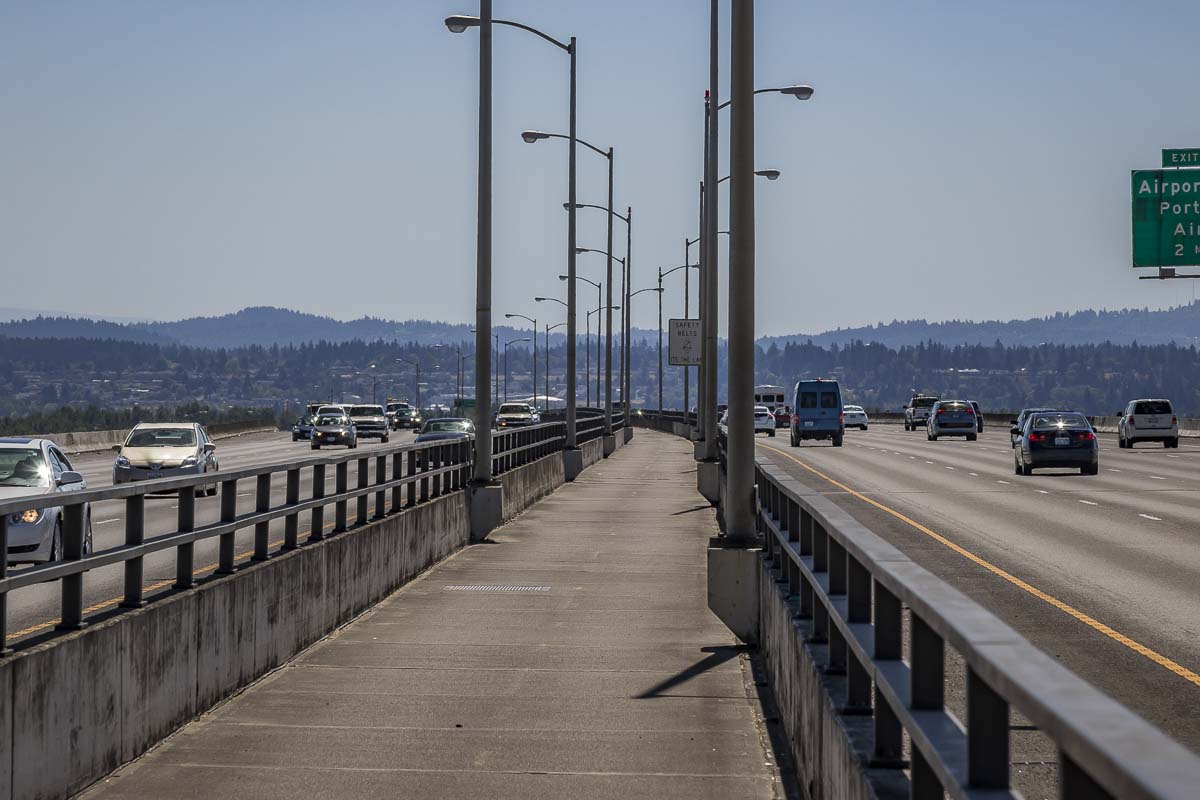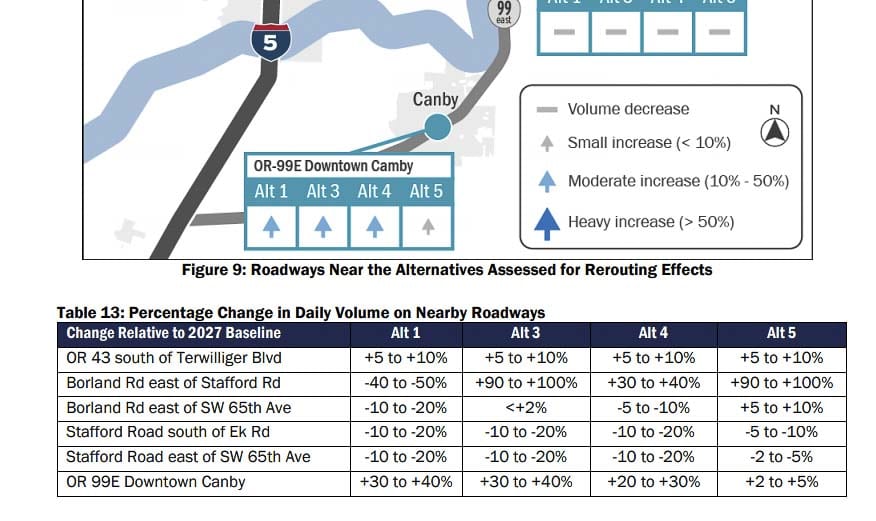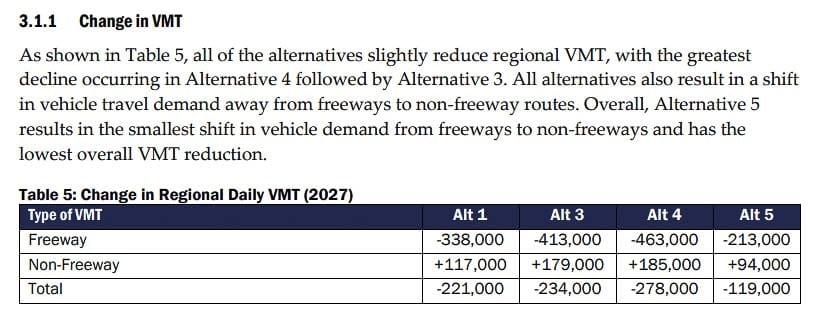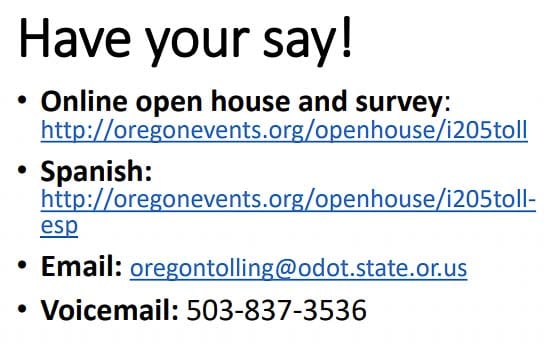Clark County Today continues its examination into Oregon’s proposed tolling plans for I-205 and I-5 with a look at the potential of traffic diversion
Oregon Department of Transportation (ODOT) staff members and their consultants, WSP USA, have created five alternatives, two of which they recommend move forward to the next phase of the process to gain federal approval to toll an area of Interstate 205. Those same officials are expected to expand the effort and toll a section of Interstate 5, before ultimately tolling all of both interstates in the Portland metro area beginning “at the border” with Washington.

Due to the fact that more than 70,000 Clark County drivers commute to Oregon to work each week, this first step in Oregon’s efforts to toll drivers on both I-205 and I-5 has obvious future impacts on Southwest Washington residents. The Oregon State Legislative mandated that tolling begin at the border with Washington in House Bill 2017, which was passed in July 2017.
Public comment on the “purpose and need” statement, and on each of the five alternatives for tolling I-205 has been ongoing, with the formal comment period now extended through Oct. 16. ODOT and WSP USA officials are recommending two of the five move forward in the process.
The “problem” is traffic congestion on I-205, in the area of the Abernethy Bridge near Oregon City and Hwy 213, to Stafford Road, near West Linn and the south end of Lake Oswego. According to ODOT and WSP USA, a second “problem” is a lack of revenue to be used to help reduce traffic congestion.
How do each of the alternatives created by ODOT and WSP USA stack up? Do they solve the traffic congestion problems? How do they raise money?
After briefing the Canby City Council on their alternatives, council members expressed dismay with all of the ODOT/WSP USA “solutions.” Council President Tim Dale stated emphatically: “you’re actually going to make things worse!”
Dale reminded the presenters of the ODOT/WSP USA alternatives, “it doesn’t take a rocket scientist to know that to reduce congestion on I-205, you need more lanes.”
ODOT’s Tolling Program Director Lucinda Broussard informed the members of the Canby City Council that the design for I-205 is funded, but the construction is not. It is a $400-million project that will do a seismic upgrade and add one lane to the Abernethy Bridge across the Willamette River. It will also add one lane to I-205 in each direction between Stafford Road and Hwy 213.
Traffic diversion was predicted
The increased diversion and traffic congestion in small towns was predicted by both ODOT and their WSP USA consultants during the 2018 “Value Pricing” Policy Advisory Committee (PAC) meetings. They indicated that 50,000 vehicles were presently diverting in the metro area (due to lack of vehicle capacity) and that tolling would increase diversion onto side roads by 80,000 vehicles, once tolling was fully implemented.
Clackamas County Commissioner Paul Savas, one of the 25 PAC members, pushed back at the time, complaining that the option that delivered the most congestion relief, was not being advanced.
“There was an option that’s not being considered,’’ Savas said. “Option four, which was to build a lane on both I-5 and I-205. That was discounted and then not moving forward; not by decision to this group but by decision of the process. That clearly relieved congestion more than any other alternative, judging by the scale of grading. I think it begs the question, if we had the most ideal congestion relief project of all not moving forward, then what is the purpose of the revenue.“
Citizens wonder what will happen under the current proposals? Will traffic be diverted by drivers attempting to avoid the tolls? Studies show that because there is already a lack of vehicle capacity on this section of I-205, side roads are already congested. Officials fear the tolling “alternatives” will make congestion even worse on side roads. Particularly in Canby, Oregon City, and along Willamette Falls Drive.
Highway 99E goes right through downtown Canby. ODOT projections show a 30-40 percent increase in traffic on 99E in downtown Canby. But, it too is already congested.
Canby City Councilor Sarah Spoon pointed out that Highway 99E, with its current usage, is already a source of ever-increasing complaints.
“I think a lot of our community feels like it is already kind of stressed,” she said. “It was built for a community that lived here 15 years ago. We’re growing and expanding, and traffic is only getting worse.”
The ODOT/WSP USA proposed two options would increase traffic by 30-40 percent in downtown Canby, according to information offered in ODOT’s own presentation. In another Canby location, (Boreland Road east of Stafford Road), two options would increase traffic congestion by 90-100 percent.

In downtown Oregon City, three of the options increase traffic congestion by 30 to 90 percent. Similar numbers were shown for the Oregon City Arch Bridge.
In West Linn, Alternative 4 showed a 90-100 percent increase on one section of Willamette Falls Drive. It showed a 50-60 percent increase on a different section of that same road. And Alternative 4 is one of two recommended by ODOT and WSP to move forward.
In Gladstone, Alternative 4 showed a 70-80 percent increase in traffic congestion in one location.
ODOT admits their “single largest concern” is traffic diversion. In their presentation regarding I-205 tolling they state:
“Perhaps the largest single concern in evaluating alternatives, is the effect on roadways in the vicinity of I 205 tolling due to local rerouting. While the complete effect on rerouting cannot be precisely identified by the regional model, (especially when also considering the potential for shifts in the time of trips or changes in destination to avoid tolls), the influence of these factors is likely to positively affect traffic operations on I-205. Specific local congestion effects (e.g., key intersection traffic performance relative to jurisdictional mobility standards) will be assessed through the NEPA evaluation of impacts. Additional study of the effects of rerouting on local roadways will be part of subsequent analysis using the DTA modeling tool, which will provide much more detail on rerouting impacts for use in analyzing alternatives, and ultimately identifying the preferred alternative.”
Then why did ODOT and WSP USA fail to advance PAC option 4, which according to Savas, clearly reduced traffic congestion the most? As discussed at the time, it had the least amount of traffic diversion and was best at reducing traffic congestion.
ODOT and WSP USA show the impact of current tolling proposals on I-205 as a system. The tolling will reduce the total number of vehicle miles traveled (VMT) on I-205 by 213,000 to 463,000, depending on the alternative. They recommend Alternatives 3 and 4 go forward as those two choices remove the largest numbers of vehicles from I-205. Those two alternatives also have the largest increase in traffic diversion onto side roads.
“All of the alternatives slightly reduce regional VMT, with the greatest decline occurring in Alternative 4 followed by Alternative 3. All alternatives also result in a shift in vehicle demand away from freeways to non-freeway routes” states ODOT. These range from an increase of 94,000 to 185,000 vehicle miles traveled on side roads.

ODOT spokesman Don Hamilton responded to the following question from Clark County Today: If I-205 is congested “over six hours” now, will it be congested three hours, or two hours, or four hours after the changes? “We now see 6.75 hours of congestion a day which we estimate would decrease to two hours a day after completion of both phases of the project.” stated Hamilton.
As stated by officials, the ODOT/WSP USA proposed “solutions” won’t eliminate traffic congestion, but mainly shifts traffic off I-205 to side roads. A logical question is how will ODOT serve the people by making the traffic congestion problems people want solved worse in their communities?
If ODOT doesn’t reduce traffic congestion, how do their proposals stack up in raising revenue? Clark County Today will address this question in a future article.
The ODOT I-205 tolling slide presentation can be viewed here, or here for the video presentation.
Citizens in the Portland metro area, including Clark County residents, can make input to ODOT either via their website or by leaving a phone message. The I-205 Toll Project public comment period end date has been extended from Sept. 23 to Oct. 16, as Oregon Health and Safety officials respond to ongoing wildfires.





